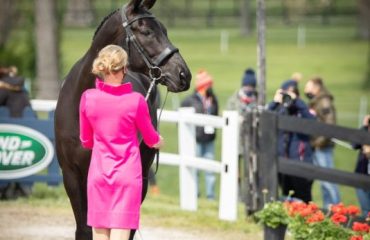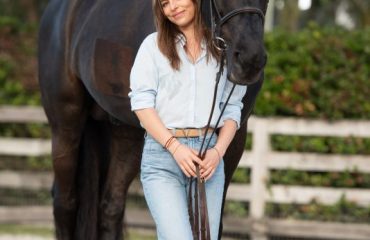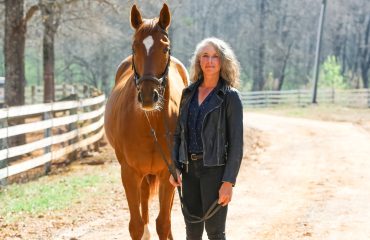
Rita Mae, cub hunting from a fixture, or location, of Oak Ridge Hunt.
Photo by Barbara Bower, www.barbarasvisions.com
By Doris Degner-Foster
Rita Mae Brown is well known for the entertaining novels she writes where household pets and other animals take an active part in solving the murder mystery. She is also an advocate for equal rights and an Emmy nominated screenwriter and poet. But before any of those accomplishments, Rita Mae rode horses. She says, “My mother would throw me on old farm horses. She was a good person, but she wasn’t going to baby me at all.”
It seems that Rita Mae learned some things about life when she learned about riding. She explains, “In order to really build a partnership with a horse you have to completely change your way of thinking. You have to meet them half way or it really isn’t going to work. Riding changes your mind and your spirit and you become much more grateful for other forms of life.”
Rita Mae’s early heroes were accomplished riders. “I would go to horse shows but what I really liked were the people in the foxhunt field. When I was little, there were some ladies who rode sidesaddle and they would take their fences in style. I don’t think I’ve ever seen anything more beautiful.”
Not surprisingly, that little girl grew up to be Master of Foxhounds and Huntsman of the Oak Ridge Hunt club near Charlottesville, Virginia. As Master, Rita Mae is the head of the foxhunt club, deciding the plan for the day’s hunting and overseeing all aspects of the hunt club. While also acting as huntsman, she is responsible for hunting the hounds, or deciding where and how the hounds will hunt on each outing. When the hounds are on the scent line of the fox, the horses and riders move off quickly to keep up with the action to watch the hounds work. Rita Mae emphasizes that in the U.S. foxes are chased but not killed. It is common for the quarry to outrun the hounds or duck into their dens, which is referred to as “going to ground.”
She hunts from her farm in Virginia that she has named Tea Time Farm. She explains that her family line originated in Britain, and although her ancestors left Britain in 1622, they still kept British customs alive. She says, “When I was a kid we always stopped at 4 o’clock for tea. It was a nice way to sit for 15 minutes and then go back out and do what you had to do.” Although friends have joked that it should be called Coca Cola Farm for Rita Mae’s fondness for the beverage.

Foxhunting2
Rita Mae wearing traditional brown tweed, informal cubbing attire.
Photo by Barbara Bower, www.barbarasvisions.com
Rita Mae’s lifestyle of riding and hunting is one that she says allows her to spend time in what she refers to as, “This incredible creation all around me.” She elaborates about the effect her lifestyle has on her when she says, “In many ways riding and hunting has made me much more sensitive to the environment, but it has also made me more sensitive to people. I’ve realized most people aren’t really doing what they want, and there’s a lot of unhappiness. They are dutiful, but they don’t have that great passion, and if they do they don’t think they can do anything with it. I want to just say, yes you can! Get outside of that crazy swirl of constant news, just bag it for a couple of hours a day if you can and go outside and be grateful for the birds and anything out there. Live! Don’t sit inside!”
“Foxhunting is not a sport for the tepid,” Rita Mae says, of riding in the hunt field. “Anybody out there is pretty capable and gutsy, but also they’re people that love life. Foxhunters tend to be vivid personalities; you meet the most interesting people.”
“One of the greatest stories I have to tell is about two people I hunted with for years, the Williamsons’s – Dick and Bea Williamson. They died close to one another, and they lived to a good age. Dick was a triple air ace so there was nothing wimpy at all about him. Their son had them cremated, which was their wish, and he put them on a little bag on the back of his saddle and he kept them there. Their son was also a foxhunter and, finally, one day on a run that he thought was worthy of mom and dad, he opened the bottom of the bag to scatter their ashes. That is so perfect!”
The individuals riding with the hunt are led by a Field Master who keeps up with the action so that riders may watch the hounds, and even possibly get a glimpse of the fox, an event in which it is proper to shout, “Tally Ho!” The group riding behind the huntsman is the first field, which is also known as first flight, because it can seem like flying when galloping fast to keep up with hounds. Everyone in the hunt field is on equal footing, literally and figuratively. Those riders who have kept up and are still on their horse at the end of a hard, fast run share mutual respect. Rita Mae points out, “It doesn’t matter how rich you are, you still have to ride the horse, and you can’t buy your way over the fence.”

Rita Mae on a cubbing hunt, which is a pre-season hunt. As the huntsman, Rita Mae is taking packed up hounds along the edge of a cornfield prior to casting, or sending hounds out to hunt. Foxes will sometimes hide out in a corn field.
Photo by Barbara Bower, www.barbarasvisions.com
She explains, “We have people in our club that barely have two nickels to rub together, God bless them, and I’m right there with them because with a writer it’s chicken one day and it’s feathers the next. And then we have people that have considerable resources, not a lot but a few. Nobody cares! It has no place in our hunt club and I would hope that it has no place in any other. There are too many parts in our society where you can buy your way in and money is the only value.” Rita Mae goes on to say of her hunt’s friendly members, “The deal here is you show up, if you can hang on through this territory and you have a sense of humor, there’s a good chance we really want you!”
Oak Ridge Hunt now has two other Joint Masters. Rita Mae laughs, “They’re my victims! I talked them into it. I was the sole master for a long time, but we were growing. I couldn’t do it all so first I asked David Wheeler, and basically I just lassoed him into it. Then both of us ganged up on Bob Satterfield and, oh, what a difference it’s made to have those two guys.” Bob and his wife Sue, who also leads the first flight, are in charge of the hunt breakfasts. A shared meal following a hunt is always referred to as a breakfast, regardless of the time of day.
“It’s such a joy to sit down with people that you went through hell and high water with.” Rita Mae says of the Satterfield’s ability to organize hunt breakfasts, “They usually pull it together and I don’t know how they do it, but they’re always pulling rabbits out of a hat. They send out an email and everybody brings something and before you know it, it’s a caloric nightmare. But I figure anything you eat at a hunt breakfast doesn’t count against you.” Her thinking is probably right because riding hard for two or three hours uses up considerable calories.
“Foxhunting also makes one really wake up to how precious and fragile our environment is. I think there’s no such thing as a foxhunter that isn’t an environmentalist.”

Rita Mae at home with her household pets. The Jack Russell Terrier on the right seems to have an opinion about having his photo taken.
Photo by Mary Motley Kalergis
Rita Mae has agreed to make allowances for those interested individuals who do not yet have the horse or the talent to ride with the first field. Like many hunts, Oak Ridge Hunt has a slower group known as second field. For those riders who are just starting out in foxhunting, they have an even slower field on occasion, a third field. Rita Mae admits, “I opposed it in the beginning. I was really blindly stupid about it and then my joint masters made me realize that not everybody has grown up with horses. In fact, there were fewer and fewer as time has gone on. So many people come into this now in their middle years. Thank God they talked me into it because it has made a world of difference for us. I think it has made a world of difference for the people in it, too.”
But of course, as the huntsman, Rita Mae rides ahead of first field. When asked about the fast pace and possibility of injury, she replies with her usual gusto, “If you’re gonna ride you could get hurt, but at least it’s on your own terms. If you get injured at least it’s because you are doing something! You could get hurt in your car.”
Riding and foxhunting is challenging, and the lessons learned there can also apply to other phases of life. A response to fear, whether it be in the hunt field or life, can apply equally. As Rita Mae advises, “You just go forward. Grab mane and kick on! There’s no turning back, you just gotta ride through it.”

Rita Mae enjoys a few moments with some of her feline friends. In her newest novel, The Litter of the Law, Rita Mae collaborates with feline co-author Sneaky Pie Brown.
Photo courtesy of Rita Mae Brown
Riding, Writing and Reading A New Sneaky Pie Novel
Rita Mae Brown’s fans will be excited to know that a new Sneaky Pie novel, The Litter of the Law, was released in October of 2013. If you haven’t joined Rita Mae and her feline companion Sneaky Pie in an action packed murder mystery, or taken a fictional foxhunting adventure with “Sister” Jane Arnold, or cozied up for a canine mystery with Baxter – then it’s time to saddle up and ride along with Rita Mae.
In the “Mrs. Murphy/Sneaky Pie Brown” series, which encompasses more than 20 books, Rita Mae collaborates with feline co-author Sneaky Pie Brown in a mystery starring Mary Minor “Harry” Haristeen, the curious cat detectives Mrs. Murphy and Pewter, and Tee Tucker, the valiant crime-solving corgi. Wish You Were Here (1990) is the first book of the Mrs. Murphy/Sneaky Pie Brown series. In Crozet, Virginia the town’s thirty-something postmistress, Mary Minor “Harry” Haristeen, has a tiger cat (Mrs. Murphy) and a Welsh Corgi (Tee Tucker), a pending divorce, and a bad habit of reading post cards not addressed to her. When Crozet citizens start turning up murdered, Harry remembers that each received a card with a tombstone on the front with the message “Wish you were here,” on the back.
In her foxhunting mysteries, which currently includes eight novels, Rita Mae writes about “Sister” Jane Arnold, the Master of the prestigious Jefferson Hunt Club. Sister is the most revered citizen in the Virginia Blue Ridge Mountain town where a rigid code of social conduct and deep-seated tradition carries more weight than money. Nearing seventy, Sister now must select a joint master to ensure a smooth transition of leadership after her death. It is an honor of the highest order – and one that any serious social climber would covet like the Holy Grail.
In her canine mystery series, Rita Mae writes about a former Wall Street trader and her faithful companion, Baxter, a wirehaired dachshund. A Nose for Justice, the first book in the series, follows Mags as she moves to her Aunt’s Nevada ranch from New York. When a hundred-year-old skeleton is unearthed on the family ranch, Mags is on the case with the help of Baxter and her Aunt’s German shepherd, King.
Rita Mae has written numerous books, including Rubyfruit Jungle, a coming of age novel about a young lesbian woman, and her autobiography Animal Magnetism, in addition to her multiple famous murder mystery series.
For more information on Rita Mae or her books, visit www.ritamaebrown.com.

Rita Mae riding through a pumpkin patch during a cub hunt.
Photo by Barbara Bower, www.barbarasvisions.com
About the writer: Doris Degner-Foster lives in Tulsa, Oklahoma and rides with Harvard Fox Hounds when she is not interviewing interesting individuals in the horse sport. She also enjoys writing fiction and is working on a middle grade book series about teenagers who ride horses and solve mysteries.














This is an excellent article about an outstanding lady. Thank you for capturing the many aspects of Rita Mae Brown. The photos are perfect. They enhance the understanding of her character and her life. Well done.